How Much Does It Cost to Rewire a 1,300 Sq Ft House?
Rewiring a house is a significant project that ensures the safety and efficiency of your home’s electrical system. Whether you’re updating an old home or addressing specific electrical issues, understanding the costs associated with rewiring is crucial for effective budgeting and planning. In this comprehensive guide, we will explore the costs involved in rewiring a 1,300 sq ft house, breaking down the expenses into detailed categories to provide a clear understanding of what to expect. We will also discuss factors that influence these costs and offer practical tips for managing your rewiring project effectively, ensuring you are well-prepared to make informed decisions.
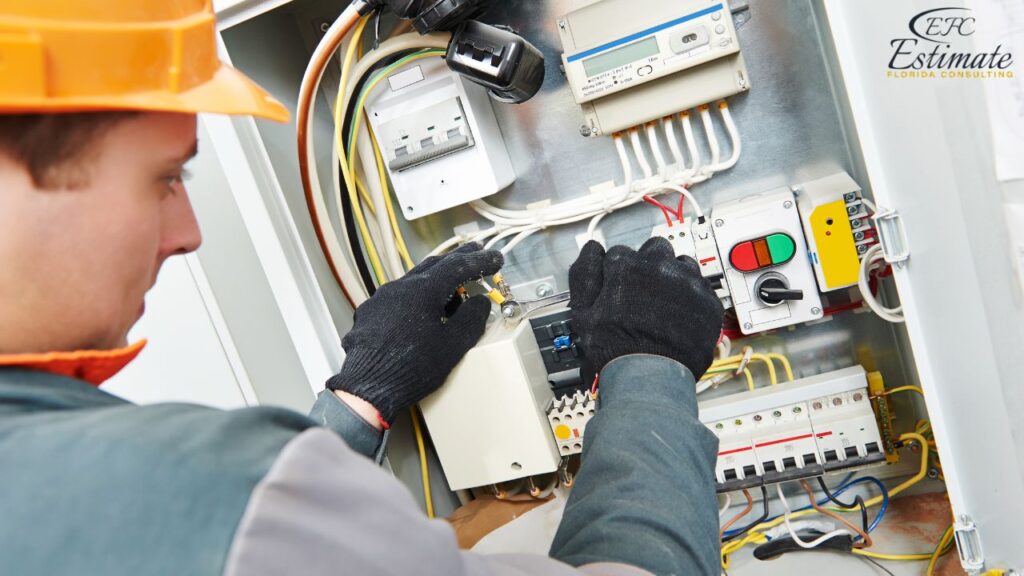
By understanding these costs and considerations, homeowners can make better choices about materials, contractors, and timelines, ultimately ensuring a successful project that enhances their home’s safety and value.
Benefits of Rewiring a House
Investing in rewiring your house offers several benefits:
Safety
Older wiring systems can pose significant safety risks, including fire hazards. Upgrading the electrical wiring enhances the safety of your home by reducing the risk of electrical fires and other hazards. This investment ensures that your home meets modern safety standards, protecting both the property and its inhabitants. It also addresses issues such as frayed wires, outdated fuse boxes, and inadequate grounding, which can all contribute to potential electrical failures. Furthermore, newer wiring can be equipped with better insulation, reducing the risk of accidental contact and improving overall home safety. The peace of mind that comes with knowing your home’s electrical system is secure and up to date cannot be overstated, particularly in areas prone to electrical storms or in homes with older infrastructures.
Increased Capacity
Modern electrical systems can handle the increased demand from today’s appliances and electronics, preventing overloaded circuits and improving overall functionality. This upgrade supports the use of high-demand devices such as air conditioners, microwaves, and home entertainment systems without frequent circuit breaker trips. Additionally, it allows for the installation of new electrical outlets in more convenient locations, enhancing the usability and layout of your living spaces. With increased capacity, you can also safely add new features like electric vehicle charging stations or advanced home office setups, ensuring your home keeps up with technological advancements. This adaptability is crucial for modern living, where the number of electronic devices and appliances continues to grow.
Energy Efficiency
Updated wiring can improve the energy efficiency of your home, potentially lowering your electricity bills by reducing power loss and ensuring efficient operation of electrical systems. Newer wiring materials and techniques can reduce resistance and heat generation, leading to more efficient power usage. This can also support the integration of energy-efficient appliances and lighting systems, further reducing your home’s overall energy consumption. Additionally, energy-efficient wiring can help minimize your carbon footprint, contributing to a more sustainable living environment.
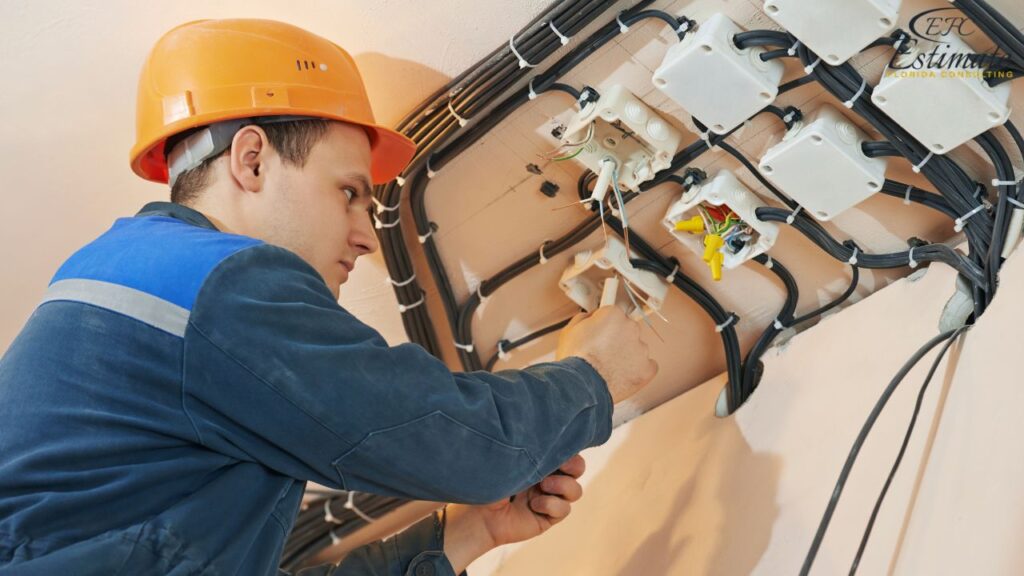
By investing in modern electrical systems, homeowners can also take advantage of smart home technologies that optimize energy usage, such as programmable thermostats and energy monitoring systems.
Increased Capacity
Modern electrical systems can handle the increased demand from today’s appliances and electronics, preventing overloaded circuits and improving overall functionality. This upgrade supports the use of high-demand devices such as air conditioners, microwaves, and home entertainment systems without frequent circuit breaker trips. Additionally, it allows for the installation of new electrical outlets in more convenient locations, enhancing the usability and layout of your living spaces. With increased capacity, you can also safely add new features like electric vehicle charging stations or advanced home office setups, ensuring your home keeps up with technological advancements. This adaptability is crucial for modern living, where the number of electronic devices and appliances continues to grow.
Property Value
Rewiring can increase the value of your property, making it more attractive to potential buyers by ensuring that the electrical system meets current safety and efficiency standards. This improvement can be a significant selling point in real estate transactions, providing peace of mind to buyers regarding the home’s electrical infrastructure. A modern electrical system can also be a major advantage in home inspections, reducing the likelihood of issues arising during the sale process. Enhanced property value also means a higher return on investment, as the rewiring costs can often be recouped through a higher selling price. Additionally, homes with updated wiring may qualify for better insurance rates, further contributing to long-term savings and financial benefits.
Average Cost Breakdown
The cost of rewiring a 1,300 sq ft house can vary based on several factors, including the age of the home, the complexity of the wiring, and local labor rates. On average, the cost can range from $10,780 to $21,560 or more. Here’s a general cost breakdown:
Component | Estimated Cost (in dollars) |
Materials | $2,940 – $5,880 |
Labor | $6,860 – $13,720 |
Additional Costs | $980 – $1,960 |
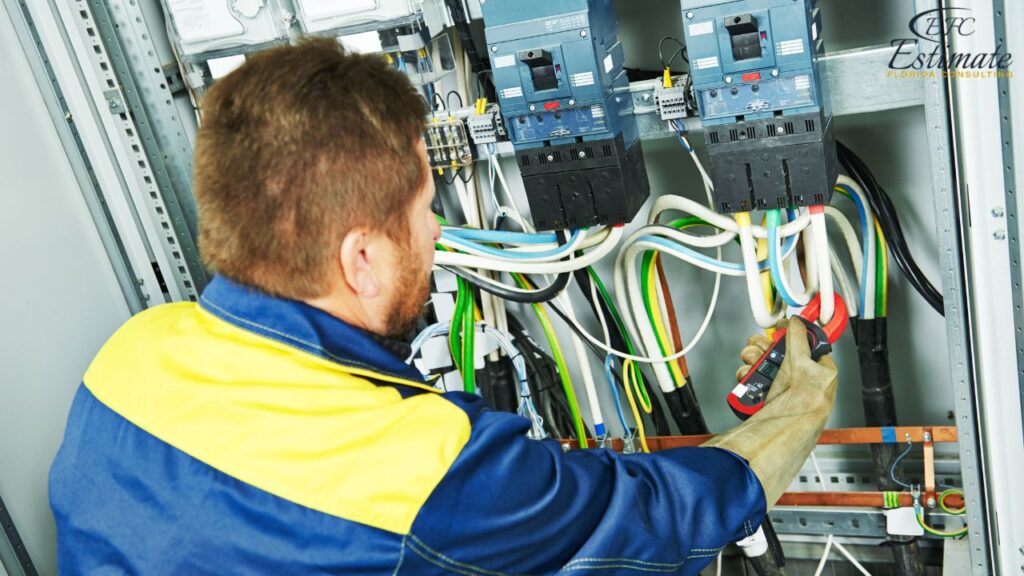
Detailed Cost Breakdown
The breakdown provided includes several components, each contributing to the overall expense. Material costs cover everything from wires to switches, while labor costs account for the time and expertise of electricians. Additional costs encompass permits, inspections, and any necessary post-project repairs. Understanding this breakdown helps homeowners anticipate expenses and plan their budgets accordingly. For instance, selecting high-quality materials and experienced electricians can initially increase costs but offers better long-term reliability and safety, preventing future issues and potentially saving money in the long run. Furthermore, the total cost can be influenced by the specific requirements of the project, such as the need for specialized fixtures or the extent of demolition and reconstruction work required to access wiring.
Factors Affecting the Cost of Rewiring a House
Age and Condition of the Existing Wiring
The age and condition of your home’s existing wiring can significantly impact the cost of rewiring. Older homes may have outdated or degraded wiring that requires more extensive work to replace.
- Old and Degraded Wiring: $11,760 – $17,640
- Moderately Aged Wiring: $9,800 – $14,700
- Relatively New Wiring: $8,820 – $11,760
Older wiring systems may need more time and effort to remove, and there may be additional challenges, such as accessing hidden wires or dealing with hazardous materials like asbestos. Homes built before certain safety standards were implemented might have wiring that no longer meets code, requiring comprehensive updates. Moreover, the presence of old wiring might indicate other potential structural issues that need to be addressed simultaneously, further increasing the overall project cost. These factors can contribute to delays and additional labor, significantly impacting the project timeline and budget.
Complexity of the Wiring
The complexity of the wiring system can also affect the cost. Homes with more complex electrical systems, such as those with multiple circuits, advanced lighting setups, or integrated smart home systems, will require more work.
- Basic Wiring: $9,800 – $13,720
- Intermediate Wiring: $13,720 – $17,640
- Complex Wiring: $17,640 – $21,560+
Complex wiring projects may involve additional labor for installing specialized components, such as dimmer switches, home automation systems, or advanced security systems. These projects often require more sophisticated planning and execution, leading to higher labor costs. Additionally, the integration of technology like smart home systems demands precise and careful installation to ensure everything works seamlessly, necessitating highly skilled electricians who command higher fees. This complexity can also extend the duration of the project, requiring detailed coordination among various contractors and specialists.
Access and Accessibility
The ease of access to your home’s wiring can influence the cost. Homes with easily accessible wiring, such as those with unfinished basements or attics, will be less expensive to rewire than homes with finished walls and ceilings.
- Easily Accessible Wiring: $9,800 – $13,720
- Moderately Accessible Wiring: $13,720 – $17,640
- Difficult to Access Wiring: $17,640 – $21,560+
Rewiring homes with finished interiors may require more labor for cutting and patching drywall, which can increase both time and costs. Accessibility issues might also arise from architectural features or the presence of insulation that complicates the process. For instance, homes with intricate molding or custom-built features may require careful disassembly and reassembly, adding to the labor intensity and overall project cost. The extent of accessibility can also impact the safety and efficiency of the project, as more challenging environments may require additional safety precautions and equipment.
90% More Chances to Win Projects With Our Estimate!
- Multi-Family Building
- Hotel Building
- Hospital Building
- Warehouse Building
- School & University Building
- High-Rise Building
- Shopping Complex
- Data Center Building
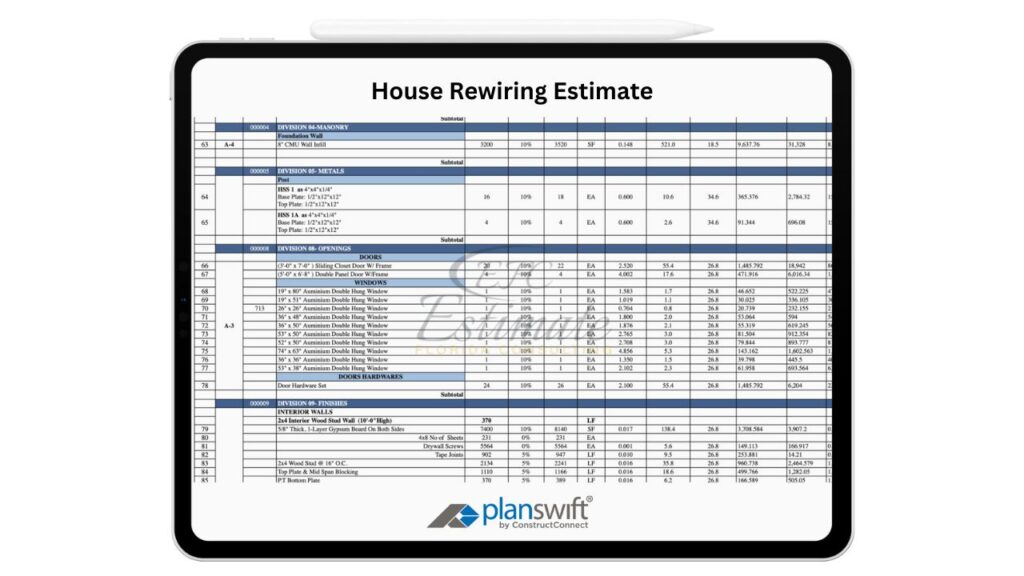
Location and Local Labor Rates
Labor costs can vary significantly based on geographic location. Urban areas with a high cost of living generally have higher labor rates compared to rural areas. Local building codes and regulations can also affect costs, as stricter standards may require more comprehensive work and additional inspections. In high-demand areas, finding available skilled electricians might be challenging, potentially leading to higher labor charges and longer project timelines due to limited availability. Additionally, the availability of materials and the proximity of suppliers can influence the cost and logistics of the project, impacting overall expenses and scheduling.
Permits and Inspections
Obtaining the necessary permits and passing inspections are critical steps in the rewiring process. These ensure that the work complies with local building codes and standards. Costs for permits and inspections can vary widely depending on your location and the scope of the project. In some regions, multiple inspections might be required at different stages of the project, adding to both the time and financial investment needed. Additionally, failing an inspection could necessitate rework, leading to further delays and increased expenses. Proper planning and coordination with local authorities can help mitigate these risks, ensuring a smoother and more predictable project flow.
Cost Breakdown by Component
Materials
The cost of materials includes wiring, outlets, switches, circuit breakers, and other necessary components. High-quality materials can increase the cost but provide better durability and safety.
Cost Breakdown for Materials:
Cost Component | Estimated Cost (in dollars) |
Wiring and Cables | $1,960 – $3,920 |
Outlets and Switches | $392 – $980 |
Circuit Breakers | $392 – $980 |
Detailed Materials Cost
Choosing high-quality materials is essential for long-term safety and efficiency. For instance, copper wiring, though more expensive, offers superior conductivity and durability compared to aluminum. Upgrading to tamper-resistant outlets and GFCI (Ground Fault Circuit Interrupter) outlets in bathrooms and kitchens can further enhance safety. These materials also contribute to the longevity of your electrical system, potentially reducing maintenance costs and the need for future upgrades. High-grade circuit breakers and surge protectors can safeguard your home’s electrical system against power surges, adding another layer of protection.
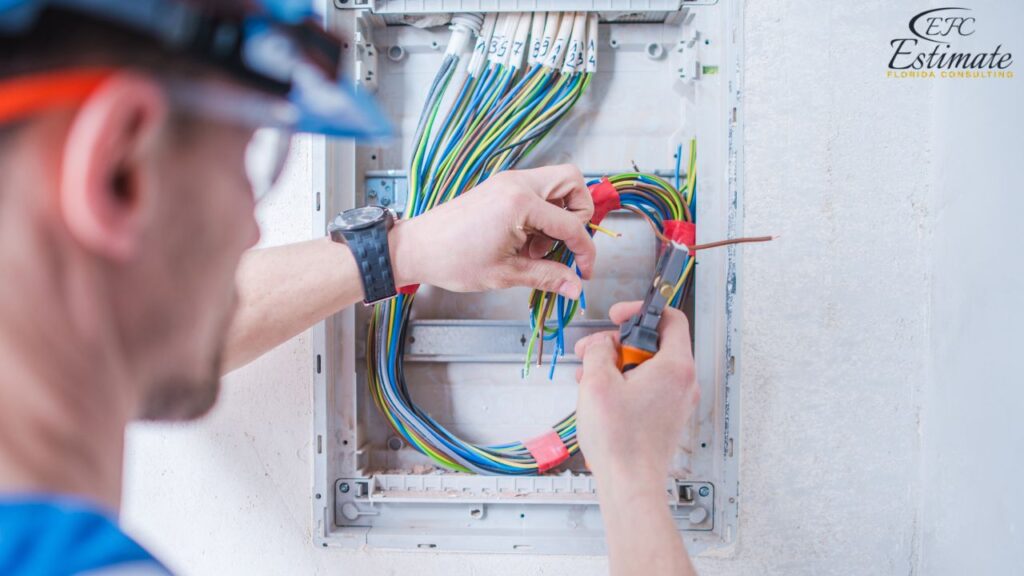
Additionally, investing in advanced insulation materials for wiring can improve overall energy efficiency and reduce heat generation, contributing to safer and more cost-effective operation.
Labor
Labor costs include the time and expertise required to remove the old wiring, install the new wiring, and ensure proper operation. The total labor cost can vary based on the complexity of the project and the rates charged by local electricians.
Cost Breakdown for Labor:
Cost Component | Estimated Cost (in dollars) |
Removal of Old Wiring | $1,960 – $3,920 |
Installation of New Wiring | $3,920 – $7,840 |
Testing and Inspection | $980 – $1,960 |
Detailed Labor Cost
The labor component is often the largest portion of the rewiring budget. Experienced electricians charge higher rates, but their expertise ensures that the work is done correctly and safely. The labor cost also includes the time spent on thorough testing and inspection of the new wiring system to ensure it meets all safety standards and regulations. Skilled electricians also offer warranties on their work, providing additional peace of mind. Detailed labor costs also cover preparatory work such as creating detailed wiring plans, coordinating with other contractors, and managing project timelines. This thorough approach minimizes the risk of errors and ensures a higher quality installation that can withstand the test of time.
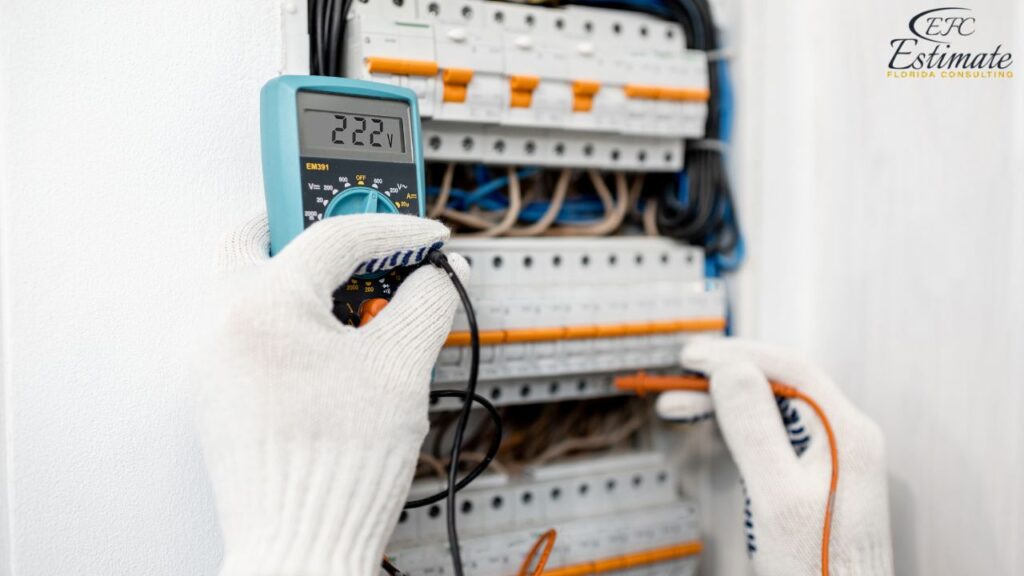
Additional Costs
Additional costs can include permits, inspections, and any necessary repairs to walls or ceilings after the rewiring is complete. These costs can vary depending on local regulations and the specific requirements of the project.
Cost Breakdown for Additional Costs:
Cost Component | Estimated Cost (in dollars) |
Permits and Inspections | $392 – $980 |
Wall and Ceiling Repairs | $392 – $980 |
Miscellaneous Expenses | $196 – $588 |
Detailed Additional Costs
Obtaining the necessary permits and passing inspections are critical steps in the rewiring process. These ensure that the work complies with local building codes and standards. Repairing walls and ceilings after rewiring can add to the overall expense, especially in homes with intricate interior designs or expensive finishes. Ensuring all aspects of the project meet regulatory standards can prevent costly fines and further work down the line. Additional costs may also include fees for waste disposal, temporary accommodations if the rewiring makes the home uninhabitable, and potential landscaping repairs if exterior work is required. By budgeting for these expenses in advance, homeowners can avoid unexpected financial strain and ensure a smoother project execution.
Using a Rewiring Cost Estimator
A rewiring cost estimator can help you plan and budget your project effectively. Here’s how to use it:
Input House Details
Enter the size, age, and condition of the house to get a customized estimate. Accurate information ensures that the estimate reflects the specific needs of your project. For example, noting whether your house has an attic or basement can influence the accessibility assessment. Detailed information about the existing electrical system, including the location of the main panel and the number of existing circuits, can also provide more accurate cost predictions.
Download Template For Electrical Project Breakdown
- Materials list updated to the zip code
- Fast delivery
- Data base of general contractors and sub-contractors
- Local estimators

Select Wiring Complexity
Choose the complexity of the wiring system, such as basic, intermediate, or complex. The estimator will provide cost ranges based on the selected complexity. This choice should reflect not only your current needs but also any future plans for additional electrical loads or smart home features. For instance, if you plan to install a home theater system, electric vehicle charging station, or advanced security system in the future, opting for a more complex wiring system now can prevent costly upgrades later.
Customize Features
Add any additional features or customization options to see how they affect the overall cost. This customization helps you balance initial costs with long-term value. Features such as home automation systems, advanced security systems, or high-end lighting fixtures can significantly impact the final cost. Including these features in your initial plan can ensure seamless integration and optimal performance, enhancing the overall functionality and appeal of your home.
Review Cost Breakdown
Review the detailed cost breakdown, including materials, labor, and additional costs. A clear breakdown helps you understand where your money is going and identify potential areas for savings. This review process can also highlight any unexpected expenses, allowing you to adjust your budget accordingly. Understanding the detailed breakdown can help you prioritize essential upgrades and identify opportunities for cost-saving measures without compromising safety or quality.
Plan and Budget
Use the cost estimate to plan and budget your project, considering any additional costs such as permits and wall repairs. Proper planning ensures that you are prepared for all aspects of the rewiring process, from start to finish. This foresight can help prevent delays and additional expenses, ensuring a smoother project execution. Effective budgeting also includes setting aside a contingency fund for unexpected issues, such as discovering hidden damage or needing to upgrade the main electrical panel to accommodate new wiring.
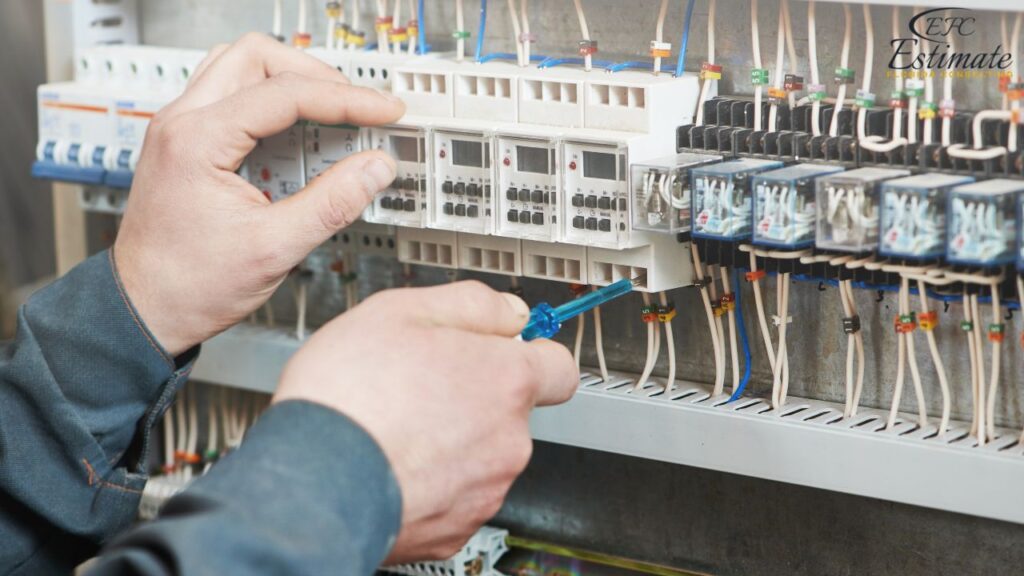
Tips for Managing Rewiring Projects
Hire a Qualified Electrician
Hiring a licensed and experienced electrician is crucial for ensuring the quality and safety of the rewiring work. Verify the electrician’s credentials and ask for references to ensure they have a good track record. A qualified electrician will be familiar with local building codes and can help navigate the permitting process. Additionally, experienced electricians are more likely to complete the job efficiently, reducing the risk of costly mistakes and ensuring that the work is done correctly the first time.
Plan for Temporary Disruptions
Rewiring a house can be disruptive, as it often involves cutting into walls and ceilings. Plan for temporary disruptions to your daily routine, including possible periods without electricity. Discuss the project timeline with your electrician to understand how long the rewiring will take and make necessary arrangements. Consider temporary accommodations if the work is extensive or if you have young children, elderly family members, or pets who might be affected by the noise and disruption.
Budget for Contingencies
Unexpected issues can arise during a rewiring project, such as discovering additional repairs that need to be made. Budget for contingencies by setting aside extra funds to cover unforeseen expenses. This can help avoid delays and ensure the project stays on track. Common unforeseen issues include discovering outdated or damaged infrastructure, encountering unexpected building code violations, or needing to upgrade other home systems to accommodate the new wiring.
Communicate Clearly with Your Electrician
Clear communication with your electrician is essential for a successful rewiring project. Discuss your expectations, timelines, and any specific requirements you have. Regular updates and open lines of communication can help address any issues promptly and keep the project moving smoothly. Ensure that your electrician understands your priorities and preferences, such as the placement of outlets and switches or the inclusion of specific features like dimmer switches or USB outlets.
Consider Future Needs
When planning your rewiring project, consider your future electrical needs. This includes potential upgrades to your home, such as adding new appliances, expanding living spaces, or integrating smart home technology. Planning for future needs can save money and prevent the need for additional rewiring work later on. By anticipating future demands, you can design a more robust and flexible electrical system that can easily accommodate new technologies and lifestyle changes.
Get 5 New Leads Next 7 Days With Our System
- Multi-Family Building
- Hotel Building
- Hospital Building
- Warehouse Building
- High-Rise Building
- Shopping Complex
Ensure Proper Permits and Inspections
Ensure that all necessary permits are obtained and that the work is inspected by local authorities. This ensures that the rewiring complies with building codes and safety standards. Proper permits and inspections can also prevent issues if you decide to sell your home in the future. Working with a qualified electrician who is familiar with local regulations can streamline this process, ensuring that all paperwork is handled correctly and that inspections are passed without complications.
Conclusion
Rewiring a 1,300 sq ft house is a crucial investment that enhances safety, efficiency, and the overall value of your home. With costs ranging from $10,780 to $21,560, this project requires careful budgeting and planning. Key factors influencing costs include the age and condition of existing wiring, the complexity of the new system, accessibility, local labor rates, and additional expenses such as permits and inspections. By hiring a qualified electrician, planning for disruptions, and considering future electrical needs, homeowners can ensure a successful rewiring project. Understanding these elements helps in making informed decisions, ultimately leading to a safer, more efficient, and higher-value home.
FAQs
The average cost to rewire a 1,300 sq ft house ranges from $10,780 to $21,560, depending on various factors such as the condition of the existing wiring, the complexity of the project, accessibility, and local labor rates.
Rewiring your house improves safety by reducing fire hazards, increases electrical capacity to handle modern appliances, enhances energy efficiency, and can boost your property value by meeting current safety and efficiency standards.
- Safety: Reduces the risk of electrical fires and meets modern safety standards.
- Increased Capacity: Supports modern appliances and reduces the risk of overloaded circuits.
- Energy Efficiency: Lowers electricity bills by reducing power loss and ensuring efficient operation.
- Property Value: Increases the home’s value and attractiveness to potential buyers.
- Materials: $2,940 – $5,880
- Labor: $6,860 – $13,720
- Additional Costs: $980 – $1,960
- Total Cost: $10,780 – $21,560+
- Age and Condition of the Existing Wiring: Older wiring requires more extensive work.
- Complexity of the Wiring: More complex systems with advanced features cost more.
- Access and Accessibility: Easier access reduces labor costs.
- Location and Local Labor Rates: Costs vary by geographic location.
- Permits and Inspections: Costs for permits and required inspections vary by location.
- Input House Details: Enter the size, age, and condition of the house.
- Select Wiring Complexity: Choose basic, intermediate, or complex.
- Customize Features: Add additional features to see their impact on cost.
- Review Cost Breakdown: Understand where your money is going.
- Plan and Budget: Use the estimate to plan and budget your project.
- Hire a Qualified Electrician: Ensure quality and safety.
- Plan for Temporary Disruptions: Prepare for periods without electricity.
- Budget for Contingencies: Set aside extra funds for unexpected issues.
- Communicate Clearly with Your Electrician: Discuss expectations and timelines.
- Consider Future Needs: Plan for potential future electrical demands.
- Ensure Proper Permits and Inspections: Comply with local codes and standards.
Google Reviews



Process To Get Electrical Cost Estimate Report
Here I am going to share some steps to get electrical cost estimate report.
-
You need to send your plan to us.
You can send us your plan on info@estimatorflorida.com
-
You receive a quote for your project.
Before starting your project, we send you a quote for your service. That quote will have detailed information about your project. Here you will get information about the size, difficulty, complexity and bid date when determining pricing.
-
Get Estimate Report
Our team will takeoff and estimate your project. When we deliver you’ll receive a PDF and an Excel file of your estimate. We can also offer construction lead generation services for the jobs you’d like to pursue further.

